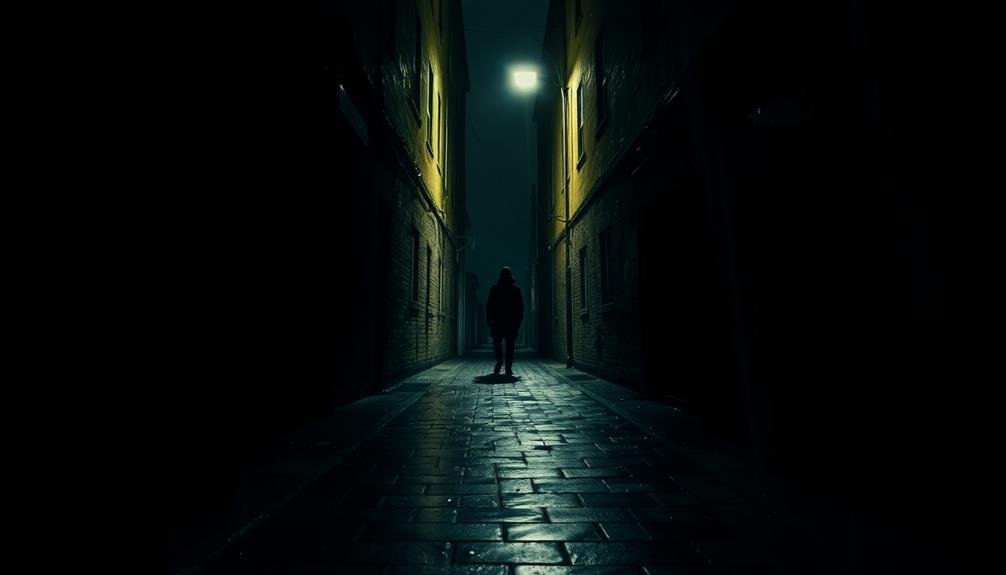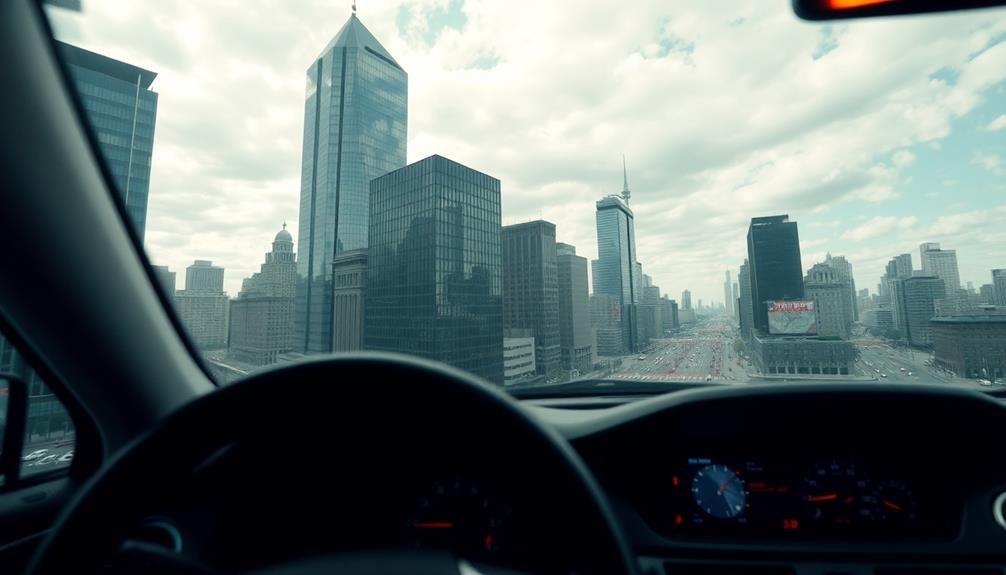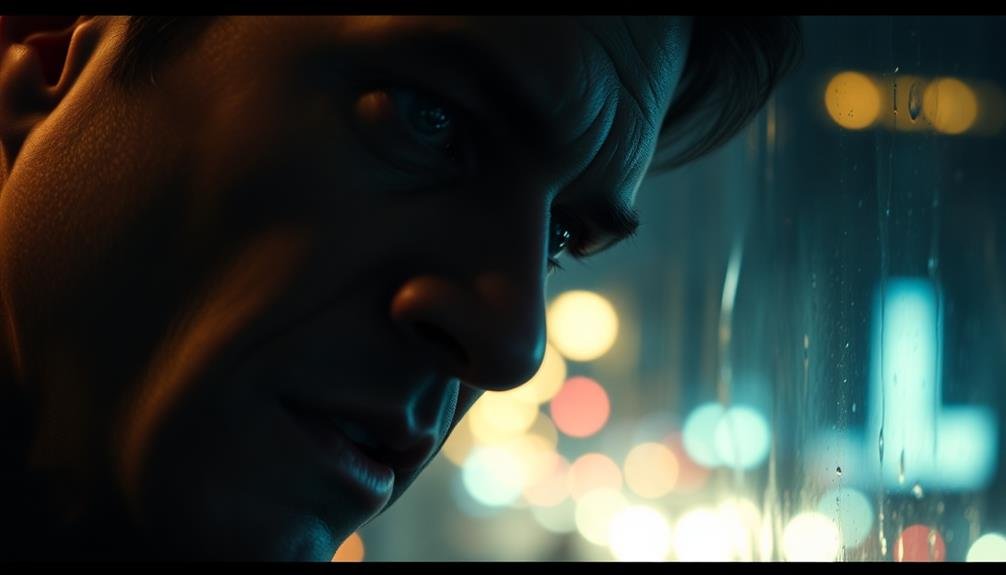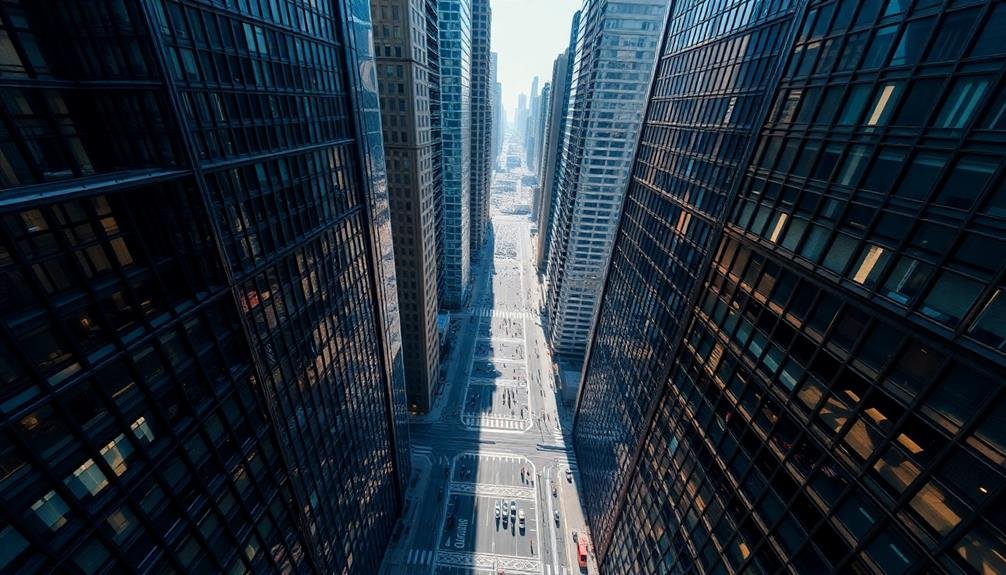Tilt discloses transform ordinary scenes into cinematic masterpieces, enchanting you with their power to expose hidden landscapes. They create jaw-dropping visual experiences by dramatically shifting perspectives and heightening your sense of scale. These techniques build visual suspense, disorienting you and forcing a recalibration of scene understanding. Tilt discloses master vertical space, guiding your eye and affecting emotional responses. They're perfect for crafting unforgettable opening shots and seamless shifts between scenes. By balancing speed and timing, filmmakers control the flow of information, building anticipation and enhancing the overall narrative. Discover how these techniques can elevate your viewing experience to new heights.
Unveiling Hidden Landscapes

Panoramas unfold as the camera slowly tilts upward or downward, disclosing expansive landscapes previously hidden from view. You'll notice how this technique transforms a seemingly ordinary scene into a breathtaking vista, surprising the audience with unexpected beauty or grandeur.
As the tilt disclosure progresses, you're taken on a visual journey. What starts as a closeup of grass might gradually give way to rolling hills, distant mountains, or a sprawling cityscape. This gradual revealing builds anticipation and awe, allowing you to experience the landscape's scale and majesty.
Tilt reveals can also work in reverse, starting with a wide shot and slowly tilting down to focus on a specific detail. You'll see how this technique can add context or create contrast between the vast environment and a small, significant element within it.
When used effectively, tilt reveals don't just show landscapes; they tell stories. They can establish setting, convey mood, or highlight the relationship between characters and their surroundings.
You'll find that these shots often serve as powerful opening or closing sequences, leaving a lasting impression on viewers.
Dramatic Perspective Shifts

You'll notice how tilt reveals dramatically shift perspective in cinematic shots, altering spatial relationships between objects and characters on screen.
These techniques can exaggerate depth perception, making scenes appear more expansive or claustrophobic than they truly are.
Altering Spatial Relationships
Tilt discloses excel at dramatically altering spatial relationships within a shot. As you watch the camera tilt, you'll notice how objects and characters seem to shift in relation to one another. This technique can create a sense of disorientation, emphasizing power dynamics or revealing hidden elements within the frame.
By changing the vertical axis, tilt discloses manipulate your perception of space and scale. They can make characters appear larger or smaller, emphasize height differences, or create a sense of vertigo. This alteration of spatial relationships adds depth and dimension to your shots, enhancing the visual storytelling.
| Effect | Example |
|---|---|
| Emphasize height | Skyscraper reveal |
| Create unease | Tilting horizon |
| Show power dynamics | Looking up at authority figure |
| Reveal hidden elements | Tilting to show danger below |
| Disorient viewers | Rapid tilt during action sequence |
When you use tilt discloses effectively, you're not just moving the camera; you're reshaping the viewer's understanding of the scene. This technique can build tension, surprise audiences, or gradually reveal vital plot elements. By altering spatial relationships, you're guiding the audience's focus and emotional response, making tilt discloses a powerful tool in your cinematic arsenal.
Exaggerating Depth Perception
Through tilt reveals, filmmakers can dramatically exaggerate depth perception, creating striking perspective shifts. You'll notice how this technique manipulates your spatial awareness, making objects appear closer or farther away than they actually are. As the camera tilts, it distorts the vertical lines in the frame, causing a forced perspective that tricks your brain into perceiving exaggerated depth.
When you see a tilt reveal in action, you'll often feel a sense of vertigo or disorientation. That's because the technique plays with your innate understanding of how spaces should look. It's particularly effective in architectural shots or scenes with tall structures. As the camera tilts up or down, you'll see buildings stretch impossibly high or canyons plunge to dizzying depths.
This exaggeration of depth isn't just for show; it's a powerful storytelling tool. It can emphasize a character's smallness in a vast world or highlight the imposing nature of a threat.
You'll find that tilt reveals add a layer of visual drama that flat, static shots simply can't match, making scenes more immersive and emotionally impactful.
Creating Visual Disorientation
Inducing a sense of visual disorientation, tilt reveals excel at creating dramatic perspective shifts that can leave viewers feeling off-balance. As you watch a tilt reveal unfold, you'll notice how it challenges your perception of space and gravity. The camera's movement forces you to reassess the scene's spatial relationships, often revealing unexpected elements or altering your understanding of the environment.
You'll find that tilt reveals are particularly effective in establishing a character's mental state or emphasizing the surreal nature of a situation. By tilting the camera, filmmakers can make familiar spaces appear alien or unstable, mirroring a character's inner turmoil or the narrative's tension.
This technique can also be used to shift between reality and fantasy, blurring the lines between what's real and imagined. When executed skillfully, tilt reveals can create a visceral reaction in viewers. You might feel a momentary sense of vertigo or discomfort as your brain struggles to reconcile the shifting perspective.
This disorientation can be heightened by combining tilt reveals with other camera movements or visual effects, intensifying the impact and leaving a lasting impression on the audience.
Heightened Sense of Scale

Scale becomes a powerful storytelling tool when cinematographers employ tilt disclosures. You'll notice how these shots can transform your perception of size and space, making ordinary objects appear monumental or vast landscapes seem endless. By slowly tilting the camera up or down, filmmakers create a sense of anticipation and awe as they disclose the true scale of a subject.
Tilt disclosures excel at heightening the sense of scale in various ways:
- Emphasizing vertical elements like skyscrapers or towering cliffs
- Contrasting small foreground objects with expansive backgrounds
- Revealing unexpected depths or heights
- Gradually exposing the sheer magnitude of a scene or character
You'll find that these shots often elicit a visceral reaction, making you feel small in comparison to the disclosed subject. They're particularly effective in establishing shots, introducing new locations, or emphasizing a character's insignificance in the face of overwhelming odds.
Creating Visual Suspense

When you employ tilt reveals in cinematic shots, you're able to create visual suspense through disorienting perspective shifts.
As the camera tilts, you'll notice how it can distort the viewer's sense of balance and spatial awareness, effectively heightening emotional tension.
This technique forces your audience to recalibrate their understanding of the scene, keeping them on edge and deeply engaged with the unfolding narrative.
Disorienting Perspective Shifts
Filmmakers employ disorienting perspective shifts to create visual suspense, keeping viewers on edge and heightening emotional impact.
You'll notice this technique when the camera suddenly tilts, rotates, or changes angle, forcing you to recalibrate your understanding of the scene. It's a powerful tool that can make you feel uneasy, confused, or even dizzy, mirroring the characters' experiences.
These perspective shifts can be subtle or dramatic, depending on the desired effect. You might see:
- A slow tilt revealing a hidden danger
- A quick snap to an upside-down view during action sequences
- A gradual rotation as a character loses consciousness
- A rapid series of angle changes to convey chaos or panic
Heightening Emotional Tension
Tilt reveals are a powerful cinematic technique that can heighten emotional tension and create visual suspense. As a filmmaker, you can use this method to gradually disclose vital elements of a scene, keeping your audience on the edge of their seats. By slowly tilting the camera up or down, you're controlling the flow of information and building anticipation.
Imagine a horror scene where you start with a close-up of a character's frightened face. As you tilt down, you reveal their trembling hands, then a bloodstained knife, and finally, a body on the floor. This deliberate pacing amplifies the emotional impact, allowing viewers to process each new piece of information.
You can also use tilt reveals to subvert expectations. Start with a seemingly innocent shot, then tilt to expose a surprising or shocking element. This contrast can create a sudden shift in mood or narrative direction.
Seamless Transitions Between Scenes

Smooth scene changes are the hallmark of skilled cinematography. Tilt reveals offer a powerful tool for seamlessly shifting between scenes, creating a fluid visual narrative that keeps your audience engaged.
By using vertical camera movements, you can effortlessly guide viewers from one setting to another, maintaining the flow of your story without jarring cuts.
When incorporating tilt reveals for scene shifts, consider these key elements:
- Matching visual elements between scenes
- Controlling the speed of the tilt
- Utilizing foreground objects as natural wipes
- Timing the reveal to coincide with audio cues
You'll find that tilt reveals can effectively bridge disparate locations, time periods, or even abstract concepts.
For example, you might start with a close-up of a character's face, then tilt up to reveal an entirely new environment. This technique not only creates a visually striking shift but also allows you to convey information about the relationship between the two scenes.
Revealing Story Elements Gradually

Building suspense and intrigue is at the heart of effective storytelling. Tilt reveals offer a powerful tool to gradually disclose vital story elements, keeping your audience on the edge of their seats. As you slowly tilt the camera, you're not just changing the frame; you're controlling the flow of information to your viewers.
By starting with a tight focus on a specific detail, you can pique curiosity and set the stage for a larger revelation. As the camera tilts, you'll gradually expose more of the scene, allowing the audience to piece together the narrative puzzle. This technique works wonders for introducing characters, revealing plot twists, or disclosing important set pieces.
You can heighten the impact by carefully timing your tilt reveals. Sync them with dialogue, music cues, or sound effects to create a more immersive experience.
Don't rush the reveal; let tension build as viewers anticipate what's coming next. Remember, it's not just about what you show, but how and when you show it. By mastering tilt reveals, you'll craft cinematic moments that resonate long after the credits roll.
Enhancing Emotional Impact

Tilt reveals can greatly enhance the emotional impact of a scene by heightening dramatic tension.
You'll notice how a carefully executed tilt shot can gradually reveal essential elements, building anticipation and intensifying the viewer's emotional response.
These shots also effectively convey a character's perspective, allowing you to experience their emotions as they discover or react to something within the frame.
Heightening Dramatic Tension
Many filmmakers employ tilt reveals to ratchet up the tension in significant scenes. By slowly disclosing elements of the frame, you're building anticipation and keeping your audience on the edge of their seats. This technique works particularly well in suspense and horror genres, where the unknown is a powerful tool for creating unease.
When you use a tilt reveal, you're controlling the flow of information to your viewers. You can strategically hide vital details until the perfect moment, maximizing their impact when finally revealed. This gradual disclosure heightens the dramatic tension by:
- Delaying gratification
- Creating a sense of mystery
- Forcing viewers to imagine what's coming
- Amplifying the emotional payoff
The deliberate pacing of a tilt reveal also gives your audience time to process what they're seeing and form their own expectations. As the camera slowly tilts, you're inviting viewers to actively engage with the scene, making predictions and filling in the blanks.
This involvement deepens their investment in the story and intensifies the emotional response when the full picture is finally revealed.
Conveying Character Perspective
Beyond heightening tension, tilt discloses excel at conveying a character's perspective, enhancing the emotional impact of a scene. You'll find that these shots can immerse viewers in a character's emotional state, whether it's awe, fear, or confusion.
When you use a tilt disclose, you're guiding the audience's eye along the same path as the character's gaze. This technique allows you to experience the scene through the character's eyes, creating a powerful connection. You'll notice how the gradual revelation of information mirrors the character's process of discovery or realization.
Consider these emotional states and their corresponding tilt reveal directions:
| Emotion | Tilt Direction | Effect |
|---|---|---|
| Awe | Upward | Reveals grandeur or scale |
| Fear | Downward | Exposes danger or depth |
| Confusion | Diagonal | Disorients the viewer |
| Anticipation | Slow upward | Builds suspense gradually |
Showcasing Architectural Grandeur

Architectural marvels come to life through the dynamic use of tilt disclosures in cinematic shots. You'll find this technique particularly effective when showcasing towering skyscrapers, ornate cathedrals, or sprawling cityscapes. As the camera slowly tilts upward or downward, it gradually discloses the full grandeur of the structure, creating a sense of awe and wonder in the audience.
Tilt disclosures can emphasize various aspects of architectural design:
- Scale: Revealing the true height of a building from ground to sky
- Detail: Slowly exposing intricate facades or ornamental elements
- Symmetry: Highlighting balanced architectural features
- Context: Showing how a structure fits within its surroundings
You'll notice that directors often use tilt disclosures to establish location or set the tone for a scene. This technique can make even familiar buildings feel fresh and imposing.
Mastering Vertical Space

Vertical space becomes a powerful storytelling element when harnessed through tilt reveals in cinematic shots. You'll find that these movements allow you to explore the full height of a scene, creating a sense of scale and depth that's often overlooked in traditional horizontal framing.
To master vertical space, start by identifying strong vertical lines in your composition. These could be skyscrapers, trees, or even characters standing tall. As you tilt the camera, you're guiding the viewer's eye along these lines, revealing new information and building anticipation.
Consider the emotional impact of different tilt directions. Tilting upwards can evoke feelings of awe, hope, or intimidation, while tilting downwards might convey vulnerability or a sense of vertigo. You can also play with the speed of your tilt to further enhance these emotions.
Don't forget about foreground elements. By including objects close to the camera, you'll create a more dynamic reveal as you tilt, adding layers to your composition. This technique can make even mundane spaces feel expansive and cinematic, turning vertical space into an enchanting visual journey.
Crafting Unforgettable Opening Shots

When it comes to crafting unforgettable opening shots, tilt reveals can make a powerful impact. They set the tone for your entire film, drawing viewers in and leaving them enthusiastic for more. To create a truly memorable opening with a tilt reveal, you'll want to reflect on several key elements.
First, choose your subject carefully. Whether it's a towering skyscraper, a natural wonder, or a character's face, make sure it's visually striking and relevant to your story.
Next, plan your camera movement meticulously. The speed and direction of your tilt can dramatically affect the emotional resonance of the shot.
To maximize the impact of your tilt reveal opening, keep these tips in mind:
- Start with an intriguing detail before slowly revealing the bigger picture
- Use lighting to your advantage, creating contrast or highlighting specific areas
- Incorporate sound design to enhance the visual reveal
- Think about combining the tilt with other camera movements for added dynamism
Techniques for Smooth Tilt Reveals

Mastering smooth tilt reveals is essential for creating polished, professional-looking shots. To achieve this, you'll need to focus on several key techniques.
First, invest in a high-quality fluid head tripod. This equipment will provide the smooth, controlled movement necessary for a flawless tilt reveal.
Practice your hand-eye coordination and develop a steady touch. Start with slow, deliberate movements and gradually increase your speed as you become more comfortable. Use your non-dominant hand to support the camera while your dominant hand controls the tilt.
Experiment with different speeds for your tilt reveals. Slow tilts can build suspense, while faster ones can create excitement or surprise. Always match the speed of your tilt to the mood and pacing of your scene.
Consider using a motorized gimbal for ultra-smooth tilts. These devices can provide consistent, precise movements that are difficult to achieve manually.
Balancing Speed and Timing

How do you strike the perfect balance between speed and timing in tilt reveals? It's all about creating a sense of anticipation and delivering a satisfying payoff. You'll want to control the camera's movement to maximize the impact of your reveal.
Start by considering the content you're disclosing. A slower tilt can build tension, while a quicker one might surprise viewers. Experiment with different speeds to find what works best for your scene. Remember, timing is essential. You'll need to coordinate the tilt with other elements like dialogue, music, or sound effects.
To nail the perfect tilt reveal, keep these points in mind:
- Match the speed to the mood of your scene
- Use acceleration and deceleration for dynamic movement
- Time the reveal to coincide with key moments in your story
- Practice smooth, consistent motion for a professional look
Don't be afraid to break the rules if it serves your creative vision. Sometimes an abrupt or jerky tilt can be just what you need to create a specific effect.
Ultimately, the goal is to enhance your storytelling and captivate your audience with each carefully crafted reveal.
Frequently Asked Questions
What Equipment Is Necessary for Executing Professional-Quality Tilt Reveals?
You'll need a camera with manual controls, a sturdy tripod, and a tilt-shift lens or gimbal for smooth motion. Don't forget ND filters for outdoor shots and a field monitor for precise framing. Practice is essential.
How Can Tilt Reveals Be Effectively Combined With Other Camera Movements?
You can seamlessly blend tilt reveals with pans, dollies, or zooms. Start with a tilt, then shift into another movement. Or, combine them simultaneously for complex shots. Experiment with different speeds and directions for unique effects.
Are There Specific Genres or Types of Films Best Suited for Tilt Reveals?
You'll find tilt reveals especially effective in sci-fi, action, and thriller films. They're great for disclosing grand landscapes, towering structures, or hidden threats. Use them in horror to build suspense or in dramas for emotional impact.
What Common Mistakes Should Beginners Avoid When Attempting Tilt Reveal Shots?
When attempting tilt reveals, don't rush the movement or overuse the technique. Make certain your focus is sharp and the reveal is purposeful. Avoid shaky footage and poor framing. Practice smooth, controlled tilts to create impactful shots.
How Can Tilt Reveals Be Used Creatively in Low-Budget or Independent Productions?
You can use tilt reveals creatively in low-budget productions by:
- Revealing unexpected locations
- Showcasing DIY set designs
- Emphasizing character emotions
- Creating tension in confined spaces
- Highlighting unique props or costumes
These techniques don't require expensive equipment.
In Summary
You've now explored the power of tilt reveals in cinematic storytelling. By mastering this technique, you'll transform ordinary scenes into extraordinary visual experiences. Remember, it's not just about the movement, but the emotion and drama you create. Experiment with different speeds, angles, and subjects to find your unique style. As you practice, you'll discover endless possibilities to captivate your audience and elevate your filmmaking. Keep pushing boundaries and let your creativity soar with tilt reveals.

As educators and advocates for responsible drone use, we’re committed to sharing our knowledge and expertise with aspiring aerial photographers.




Leave a Reply